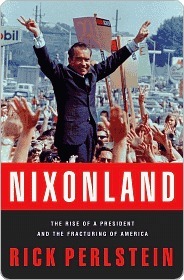More on this book
Community
Kindle Notes & Highlights
Los Angeles’ black citizens were burning down their neighborhood.
The Republican Policy Committee, meeting at the end of August, took a side on Watts—Chief Parker’s, who argued that the civil rights movement was responsible for the violence.
Richard Nixon was a serial collector of resentments. He raged for what he could not have or control.
The worst thing about HUAC, to some who took anticommunism seriously, was that it was ineffectual in building cases for the prosecution of actual Communists.
Large tracts of Joseph McCarthy’s speech were borrowed outright from Nixon’s peroration.
with the boom they had helped build, ordinary laborers were becoming ever less reliably downtrodden, vulnerable to appeal from the Republicans.
Thus a more inclusive definition of Nixonland: it is the America where two separate and irreconcilable sets of apocalyptic fears coexist in the minds of two separate and irreconcilable groups of Americans.
Pat Brown would never forget what he had learned canvassing the riot zone in 1965. Women told him they were desperate to work but couldn’t find child care; one told him what it was like to scrounge for food to keep her baby from starving the week before her monthly relief check arrived.


